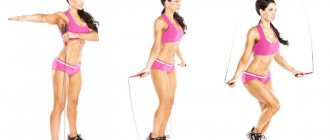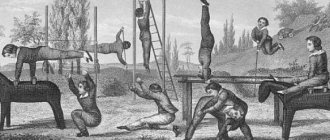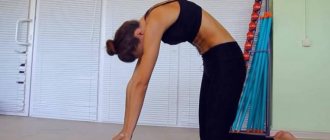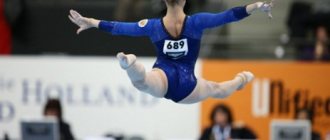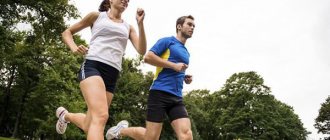A set of exercises with a large ball
A set of exercises with a large ball
1.IP - deep squat, ball in hands on the floor. 1-2-stand up, ball up, right foot back on toe, stretch; 3-4-starting position. Same thing, left leg back. Raise your head and look at the ball.
2. IP - wide stance, arms to the sides, ball in the right hand. 1-turn the torso to the right, left hand forward, ball to the left; 2-turn the torso straight, left hand with the ball to the side - inhale; 3-4 - the same, making a turn to the left and returning to the starting position.
When turning, the hand on which the ball lies is motionless. Hand movements are smooth, in one plane. When turning, do not move your legs.
3. I.p. - stand with your feet together, the ball in your hands below. 1-3-lean forward and roll the ball on the floor around your feet; 4-taking the ball, return to the starting position.
Perform the task with straight legs. Roll the ball in a closed circle once to the left, another to the right. Hold the ball all the time so that it does not roll to the side.
4. I.p. - stand with your feet together, the ball in your hands below. 1- another ball to the left up and tilt the torso to the right, right leg to the side on the toe; 2-straighten up, put your right foot, the other to the left, the ball down; 3-4 - the same, in the other direction.
Perform the exercise together, do not hold the ball below. Hands are straight all the time. When placing your foot to the side on your toes, do not transfer your body weight to it. Make all movements in one plane (facial)
5. I.p-lying on your back, the ball between your feet. 1-2-raise straight legs with the ball forward; 3-4-starting position.
In the future, you can speed up the exercise a little by doing everything in motion in 2 counts. Make sure that children raise their legs to a right angle, without bending them and without lifting their heads and shoulders from the floor.
6. “Release-Catch” I.p. - stand with legs together or slightly apart, ball in front, arms straight. Spread your arms, release the ball, quickly squat down and, without letting the ball fall to the floor, catch it with 2 hands below.
The width of the arm extension should be gradually increased. The main thing is that squats do not begin before the ball is released. You need to squat sharply and quickly on your full foot. Having mastered the exercise, give it under the count
7. I.p.-legs are slightly apart, the ball is at the shoulder on the palm of the bent arm. Throwing the ball up and catching it with 2 hands.
Throw the ball energetically, fully extending your arm upward. Perform the exercise alternately with your left and right hands, trying not to move from the spot.
8. Jump on 2 legs, directing the ball downwards with your fingers and the top of your palm.
Make sure that children direct the ball downward not with a clap, but with pressure, first gently meeting it on takeoff. Be sure to alternate movements with your right and left hands. After jumping, put the ball down and start walking.
How to cool down
After completing the exercises, you need to do a proper cool-down, which should end each workout. So, a hitch:
- Lie on the floor, arms to the sides, palms down . The legs should be in an elevated position, so they need to be placed on a fitball;
- You must remain in this position for 6-8 minutes . Breathe smoothly so that the body can relax;
- now slowly remove your feet from the ball and bend your knees . In this position, the abdominal and back muscles should be as relaxed as possible. This is good for the lower back. Stay still for another 10 minutes;
- rise carefully . Now you can begin your daily activities. Make a new habit - end each workout with a gymnastic ball with such a cool-down.
Proper cool down after exercise is very important
All experts agree that regular exercise with a gymnastic ball is an excellent way to strengthen the back muscles, get rid of pain and develop body flexibility . In addition, this activity will charge you with positive energy for the whole day.
What qualities can you develop by working with a medicine ball?
Depending on the exercise, a medicine ball can increase:
- Power . First of all, the projectile is used for various throws. Such exercises develop upper limb power - the ability to exert maximum effort in minimum time. This quality is useful in almost any sport, including team sports like American football or basketball, weightlifting, and martial arts.
- Strength endurance . Working with moderately heavy equipment for a high number of repetitions develops the muscle's ability to remain under load for longer.
- General endurance . If you use the ball in combination with other movements, such as burpees, running, pedaling on an airbike or working with a kettlebell, you can pump up your heart and lungs well. And the more intense the complex, the faster you will develop overall endurance.
- Core muscle strength . With a medicine ball, you can do many effective movements aimed at strengthening the rectus and oblique abdominal muscles.
In addition, wall-ball complexes allow you to burn a lot of calories, and for beginners they can have a positive effect on muscle strength.
What is fitball aerobics
Fitball aerobics is a popular trend in fitness, which includes performing gymnastic, aerobic and even strength exercises with a ball. Using a fitness ball allows you to change the technique and features of movements, making them more functional and safe.
You can train with a fitball individually, but the group format shows greater effectiveness, like many areas in aerobics. In general, collective exercise on a fitball is a great way to:
- develop natural muscles without a pronounced emphasis on hypertrophy;
- increase endurance;
- improve coordination and flexibility;
- effectively burn fat and improve muscle definition.
Example of a group fitball aerobics class
Also, exercises with a fitness ball are ideal for athletes who are recovering from injuries. This is especially true for problems with the spine, recovery after surgery (only when minimal stress is indicated) and the prevention of any diseases associated with the musculoskeletal system.
Gymnastics for children 3-4 months old
In order to avoid repetition, we will add to the above exercises a description of new elements of gymnastics.
Breathing exercises
Starting position: on your back. Simultaneous movement of the arms up and down and circular movements with the arms are added.
Boxing exercise
Starting position: on your back. With your arms bent at the elbows, they are alternately straightened. The movements are reminiscent of boxing. Important! The handles are fixed in the wrist joints to prevent sprains.
Half-turns and turns from back to stomach and back
Starting position: on your back. One hand clasps the child's shins from below, the index finger of the adult's other hand is placed in the baby's palm, and the remaining fingers cover his hand. Then, slightly straightening the child’s legs, you should turn his pelvis, after which the child turns his head and shoulder girdle. Make turns in both directions in a similar manner.
Exercises on the ball
Starting from 3 months, you can introduce a new type of activity - exercises on the ball. For these exercises you will need a ball with a diameter of 50-60 cm, slightly deflated.
Swinging on the ball promotes the development of coordination, the vestibular apparatus, and helps to tone the abdominal muscles, back, and legs.
The baby is placed on the ball in different ways: on the back, on the tummy, and alternately on the sides.
Swings are performed with support on the legs, with legs raised.
It is important to remember to securely secure the child on the ball.
How to choose the “ideal fitball”?
The sizes of the balls vary within 10 cm.
| Your height | Ball size |
| 152 cm and below | 45 cm |
| 154 – 170 cm | 55 cm |
| 173 – 188 cm | 65 cm |
| above 188 cm | 75 cm |
How to choose the right exercise ball?
What is fitball?
This is a lightweight plastic vinyl ball filled with air. The material from which it is made is elastic and explosion-resistant.
It is often used in stretching and flexibility exercises, stability and resistance exercises, and yoga. This equipment is great for any workout at home or in the gym.
Benefits of an Exercise Ball
There are more important reasons to buy an exercise ball than just adding extra workout options at home and speeding up your weight loss process.
However, this alone can justify the purchase of this inexpensive simulator.
The true benefit of a fitball: there are results that you cannot achieve without it.
1. Additional muscle involvement
Your body reacts to the instability created by the ball and uses many more muscles to stay balanced.
You can't get the same body response working on a flat surface or on a bench.
Exercise ball push-ups are a great example. By adding an exercise ball to your push-ups, you can activate up to 15 additional muscles.
2. Wider range of motion
While exercise balls are not the only tool for increasing range of motion, they certainly help.
Unlike doing crunches on the floor, crunches on an exercise ball allow you to expand your range of motion and even force your abdominal muscles to work even harder in response to the ball's arches.
This, of course, adds stress to the muscles, and therefore you see faster results.
Core Strength Development
Ball exercises allow you to target hard-to-reach core (stabilizing) muscles.
Working your stabilizing muscles is important not for getting into shape, but for your overall physical well-being as they support your lower back and help with everyday movements.
Just by sitting on the ball, you can already engage your stabilizer muscles and reduce the risk of injury from everyday activities, eliminate back pain and improve your posture.
Power training
You can also use the ball to replace a bench in strength training workouts such as chest presses, military presses, and even some arm exercises.
Simply lie on the ball so that it supports your upper back and head, and work your chest and arms, stabilizing your unsupported core muscles with your abs, glutes, and legs.
Using a ball as a bench replacement turns these upper body exercises into full body workouts.
The choice of exercises you can do with the ball is almost endless.
To give you an idea of the types of exercises you can do with a ball, we've created several full-body exercise ball workouts.
So grab a ball and try movements similar to the lying leg curl to tone your glutes and do planks on the ball to work your core.
How to train on a fitball
Features of training with a fitball depend on your goals:
- Losing weight – volume training, 4-5 approaches and 15-20 repetitions per exercise. Duration – from 25 to 40 minutes.
- Development of muscle mass, increase in tone - training for 20-30 minutes. 3-4 sets of each exercise with 10-15 repetitions.
- Rehabilitation and recovery – 8-10 repetitions in 3 sets. Workout for up to 20-30 minutes with long rest between sets.
- for women to work with their own body weight.
- For men , with an emphasis on muscle growth and strength, you can make exercise ball workouts more challenging with a pair of dumbbells or weights.
Gymnastics for children 4-6 months
Unconditioned reflexes gradually fade away, so the proportion of passive-active exercises increases. The number of repetitions of the same exercise also increases.
Passive exercises are performed - flexion and extension in large joints.
Circular movements in the hip joints, with the obligatory fixation of the child’s knees with your own hands.
Simultaneous flexion - extension of the legs.
Starting position: on your back. You should grab the child's legs at the bottom of the lower leg from behind, holding the feet. Bend your legs at all joints, pressing them lightly towards your stomach (the baby's knees should be spread apart), then straighten the baby's legs.
Connection of opposite and identical knee-elbow.
The range of exercises on the ball is expanding.
At this age, many children swing with interest on the ball while lifting the toy from the surface.
On the ball in a position on the back, you can rock the baby with a slight “squat” when the legs reach support.
From 5 months, you can rock the baby on its side, pushing off the support surface.


